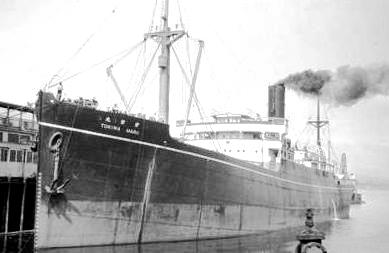RIKUGUN YUSOSEN
 (TOKIWA MARU, prewar)
(TOKIWA MARU, prewar)
TOKIWA MARU:
Tabular Record of Movement
© 2013-2016 Bob Hackett
25 February 1915:
Nagasaki. Laid down at Mitsubishi Zosen, as Yard No. 249,
a 6971-ton passenger cargo ship for the Nippon Yusen Kaisha (NYK) Line, Tokyo.
1 January 1916:
Launched and named TOKIWA MARU.
12 August 1916:
Completed and placed in NYK’s service.
8 September 1917:
Departs Yokohama for Kobe.
13 September 1917:
Departs Kobe for Seattle, Washington under NYK
Captain Ogura with a crew of 72. Does not carry passengers.
October 1917:
Arrives at Seattle.
5 October 1917:
At 0745, arrives at Victoria, B.C., Canada
13 December 1917:
Departs Hong Kong for Yokohama under NYK Captain
Ogura.
5 January 1918:
Arrives at Yokohama and later departs for Seattle,
Washington. Does not carry passengers.
January 1918:
Arrives at Seattle.
20 January 1918:
At 1740, arrives at Victoria, B.C.
10 September 1921:
TOKIWA MARU departs Singapore for Yokohama via
Shanghai and Hong Kong.
15 October 1939:
Sold to Kaburagi Kisen K. K., Tokyo.
22 July 1941:
Requisitioned by the Imperial Army as a troop transport/cargo ship. Assigned Army No. 156.
18 December 1941: The Invasion of the Philippines -“M” Operation (M
Sakusen):
At 1700, TOKIWA MARU departs Takao, Formosa for Lingayen Gulf,
Philippines in Rear Admiral (later Vice Admiral) Rear Admiral Hara Kensaburo's
(37)(former CO of TAKAO) 1st Lingayen Invasion Unit with 27 other IJA transports
escorted by DesRon 5's light cruiser NATORI, DesDiv 5's ASAKAZE, HARUKAZE and
MATSUKAZE, DesDiv 22's FUMIZUKI, MINAZUKI, NAGATSUKI and SATSUKI, minesweepers
W-15 and W-16 and subchasers CH-1, CH-2, CH-3 CH-13, CH-14 and CH-15.
The Japanese main invasion at Lingayen Gulf consists of three transport
echelons and carries the main part of LtGen Homma Masaharu's 80,000-man 14th
Army. The first echelon is composed of 27 transports from Takao under Rear
Admiral Hara , the second echelon of 28 transports under Rear Admiral (later
Vice Admiral) Nishimura Shoji (39) and the third echelon of 21 transports from
Keelung under Rear Admiral (later Vice Admiral) Hirose Sueto (39).
24 December 1941:
Lingayen Gulf. Between 0110 and 0430, the Lingayen
Invasion Convoy lands troops at Lingayen.
21 January 1942:
TOKIWA MARU departs Mutsure with transports ATSUTA,
BRAZIL, COLUMBIA, DAINICHI, FUSHIMI, GENOA, HOEISAN, MAEBASHI, KIZZAN, MOTOYAMA,
PACIFIC, REIYO, SOMEDOMO, SYDNEY, TAKETOYO, TATSUNO, TOFUKU and TSUYAMA MARUs
escorted by CruDiv 9's light cruiser OI and DesDiv 32's FUYO, ASAGAO and
KARUKAYA. The transports are carrying the 2nd Infantry Division.
26 January 1942:
Arrives at Mako, Pescadores. Later, the convoy
departs for Camranh Bay to mobilize for the Invasion of Java.
18 February 1942: Operation "J" (J Sakusen) - The Invasion of Java, Netherlands East Indies:
Vice Admiral Takahashi's Third Fleet, Western Netherlands East Indies Seizure Force departs Camranh Bay, Indochina.
Takahashi's force consists of TOKIWA MARU and 55 other troop transports carrying the 16th Army's 2nd Infantry Division
for the invasion of Java. Light cruisers YURA and NATORI and DesDivs 5, 6, 11, 12 and 22 provide escort and seaplane
tenders SANYO and KAMIKAWA MARUs provides air cover. Rear Admiral (later Vice Admiral) KURITA TAKEO’s (38)
CruDiv 7's MOGAMI, MIKUMA, SUZUYA and KUMANO provide cover.
9 March 1942:
Arrives at Bantam Bay. Lands troops.
19 March 1942: "U" transport operation to Burma (U Sakusen Yuso):
The
First Burma Transport Convoy departs Singapore consisting of 32 ships with main
body of the 56th Division: TOKIWA, AOBASAN, GENOA, GLASGOW, HARUNA, HIBURI,
HOFUKU, HOKUMEI, KAZUURA, KIZAN, KOTOHIRA, KUSUYAMA, HAVRE, MOMOYAMA, MYOKO,
NAGARA, NAPLES, NAKO, NICHIRAN, SANKO, SAKITO, SHINAI, SHINANOGAWA, SHINRYU,
SHUNSEI, SUMATRA, SYDNEY, TATEISHI, TSUYAMA, YAE MARUs and two others.
25 March 1942:
The First Burma Transport Convoy arrives at Rangoon.
16 April 1942:
At 1215, TOKIWA MARU departs Singapore for Dairen,
Manchuria in an unidentified convoy also consisting of ATLAS, FRANCE, GLASGOW,
HAVRE, HEIAN, MYOKO, MOMOYAMA, RYUNAN, TSUYAMA,and SANKO MARUs escorted by
kaibokan SHIMUSHU, torpedo boats OTORI and HIYODORI, patrol PB-35 and auxiliary
gunboat DAIGEN MARU No. 7. The convoy is transporting the IJA’s 3rd Tank Corps.
The escorts protect the convoy to latitude 16N where the convoy is escorted by
unknown units of the IJN's North China Area Fleet.
19 April 1942:
The convoy is joined by CALCUTTA, GENKAI and SYDNEY
MARUs transporting 422 men of the IJA 36th Airfield Battalion, 50 vehicles and
airfield equipment from Bangkok.
24 April 1942:
At 1018, arrives at Hong Kong. CALCUTTA MARU and her
two consorts are detached for Takao to refuel. At 1855, the remainder of the
convoy departs.
1 May 1942:
Most of the original convoy from Singapore arrives at Dairen.
8 July 1942:
TOKIWA MARU is transferred to the Senpaku Un´eikai (Civilian Shipping Administration) and operates as a cargo ship (C-AK).
1 May 1943:
TOKIWA MARU departs Mako in convoy No. 389 also consisting of HOKUROKU, RAKUYO, TSUSHIMA and TONAN MARUs and an unidentified ship without escort.
7 May 1943:
Arrives at St Jacques.
18 June 1943:
At 0500, TOKIWA MARU departs Imari Bay for Shanghai, China in convoy SHI-809 also consisting of GYOKUREI, KOSHIN, MIIKESAN, NICHINAN,
UGA, WAKAMATSU and WAZAN MARUs escorted by minelayer TSUBAME. [1]
E China Sea. Off Shirase, Japan. At 1837 (I), LtCdr (later Admiral/CINCPAC) John S. McCain, Jr’s (USNA '31) USS GUNNEL (SS-253) sights the convoy approaching, smoking heavily and making
maximum speed. About every ten minutes, the convoy changes course through forty to sixty degree zigzags. GUNNEL's XO/navigator plots the convoy's base course as 260°(T) towards Shanghai.
19 June 1943:
E China Sea. At about 0825 (I), after making an "end-around", McCain fires six torpedoes and gets one hit on TOKIWA MARU’s No. 7 hold, port side aft. Other torpedoes miss MIIKESAN and
UGA MARUs. At 0905, TOKIWA MARU sinks at 32-31N, 126-17E. One crewman is KIA.
The remainder of the convoy escapes and, at 1410, anchors off Saishu To (former Quelpart Island, now Cheju-do, Korea).
Author's Note:
Thanks go to Erich Muehlthaler of Germany.
- Bob Hackett
Back
to IJA Transports





